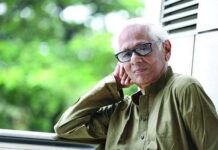Sergey Radchenko

As pro-democracy protesters in Hong Kong confronted police in the fumes of tear gas, the world looked on in admiration of their spirit and bravery and in fear of a possible crackdown.
Those who dreaded a Tiananmen-like scenario in Hong Kong can now breathe a sigh of relief. The standoff came to a peaceful end. But the protesters failed to achieve their basic goal — reversing Beijing’s Aug 31 decision to restrict elections to candidates the Chinese Communist Party approves of. They couldn’t even force the city’s chief executive, CY Leung, to resign.
Chinese President Xi Jinping can claim credit among party elites for the bloodless outcome in Hong Kong. Unlike the Beijing Politburo in 1989, he managed to preserve the Chinese Communist Party’s face without making a single concession to the demonstrators.
But there was actually little possibility that the drama in Hong Kong would end the same way as in Tiananmen. The context of the Hong Kong protests and that of Tiananmen Square were remarkably different. The domestic and world circumstances that led the Chinese leadership to order the Tiananmen massacre no longer exist.
In 1989, the Chinese economy appeared to be deteriorating rapidly. Then-General Secretary of the Chinese Communist Party Zhao Ziyang had pushed through price liberalization, triggering bank runs as people emptied their savings to stock up on goods. Prices shot up, and inflation reached a staggering 30 percent by the end of 1988.
These economic problems, amplified by public perceptions of graft and nepotism in the Communist Party ranks, were the chief reasons students took to the streets of Beijing. Calls for democracy came later.
By contrast, China today — and Hong Kong in particular — are wealthy and prosperous. There are, of course, problems remaining, as well as a pervading sense that the country’s break-neck economic growth rate cannot be sustained indefinitely. But China is largely enjoying unprecedented economic stability.
The people of Hong Kong may empathize with the protesting students, but there is little economic incentive to stage a revolution of have-nots. This is even truer of the mainland.
The 1989 protests started as student demonstrations but, before long, intellectuals, civil servants, workers and even armed police trainees were marching. They were calling for change not only in the capital but also in other Chinese cities.
The ideals of Tiananmen enjoyed support across a wide spectrum of the Chinese society. Whatever their beliefs in democracy — and there were as many opinions as protesters — the Chinese people were united in their opposition to corruption.
Today’s pro-democracy protests in Hong Kong are not like this. For one thing, Hong Kong is a relatively open society, with a high degree of transparency, comparatively little corruption and widely recognised freedom of expression, press and association.
Yes, in recent years, concerns have been voiced that some freedoms have eroded. Hong Kong society, however, faces nowhere near the level of repression experienced in China in the 1980s. The stakes in Hong Kong are not whether democracy will live or die but just how robust it can be in the face of Beijing’s determination to maintain a degree of control over the process.
It is for this reason, perhaps, that Hong Kong recently witnessed massive demonstrations opposed to the main pro-democracy group, Occupy Central. If anything, it is an indication of a divided society. Nothing of the kind took place in Tiananmen in 1989.
One key reason that the 1989 protests lasted so long was that the Chinese Communist Party leadership was divided over how to deal with the students. Zhao favored dialogue. Prime Minister Li Peng and other hardliners called for a tough response.
Party elders were also divided. For weeks, the Standing Committee of the Politburo was paralyzed, and the paralysis affected the entire party because the two power centers issued contradictory instructions.
Declassified US intelligence documents suggest that Zhao and his supporters, realizing in May that they were fighting for their political survival, actively sought to use the student movement for their own interests. They even secretly encouraged party and government officials to join the protests.
Western scholars have long known that there was a major power struggle underway in 1989. But only now is it clear just how intense it was — and how the fates of its main protagonists were intertwined with the fates of the students on Tiananmen Square.
Nothing like this occurred in Hong Kong. Of course, factionalism and power struggles within the Chinese Communist Party have not gone away. But Xi’s big power struggle — with his potential rival Bo Xilai and his backer Zhou Yongkang — has already been won. Bo is in prison for life on charges of corruption. Zhou is reportedly under house arrest. There is no one to overtly challenge Xi, and no evidence of any disagreement within the Chinese leadership over how to deal with the Hong Kong protests. Xi had the kind of freedom of action that Li and Zhao could only dream about. So Xi could bide his time and pursue a carefully calibrated policy that helped diffuse the protests
Back in 1989, after Deng Xiaoping ordered the People’s Liberation Army to clear Tiananmen Square by force, he explained that the protests were inevitable because of China’s “small climate” (economic difficulties) and the world’s “large climate.”

By “large climate” he meant the profound changes then sweeping across Europe. Communist regimes were falling like dominos. In Hungary, roundtables with the opposition led to a quiet end of Communist rule. In Poland, on the same day as the Beijing crackdown, Solidarity won the national elections.
In the Soviet Union, the public sat transfixed, watching vitriolic debates in the new Congress of People’s Deputies, overwhelmed by unheard-of openness and transparency. No wonder students on Tiananmen held up banners in Russian: “Democracy is Our Common Dream!” They, like many in Eastern Europe and the Soviet Union, felt that the surge of democracy was unstoppable and universal.
Not so today. Democracy is in retreat. Promises of the Arab Spring have led to disillusionment and, in some places, bloodbath. We all can see how democratic Iraq turned out — and is now being further democratized by U.S. airstrikes against the Islamic State, the group that aims to turn the region into a caliphate.
Or consider Ukraine. The excitement of Maidan has waned, and the country finds itself in a semi-permanent civil war and economic ruin. (Yes, partly — but not only — thanks to Russia’s interference). In Russia itself, democratic sentiment had never been lower.
The sweeping democratic climate Deng referred to in 1989 has been replaced by a sweeping authoritarian climate. The Hong Kong protests could be a spark that starts a prairie fire — except that the grass is wet and won’t light even from a flame-thrower.
Another reason that Hong Kong is not Tiananmen 2.0 is because Tiananmen is in Beijing. Hong Kong is effectively a foreign country. Most Chinese are patriotic about Hong Kong, but know little about it. It’s seen as being on par with Taipei or Seoul — an attractive but hopelessly remote world of Cantonese pop singers and Jackie Chans. Hong Kong’s problems do not resonate with the mainland.
For the pundits who saw the Hong Kong protests spreading to mainland China — let’s get to some basics. In this case, Hong Kong’s Basic Law — under which Hong Kong is in China but not quite of it. It’s a special region with its own rules and regulations, its own money and even its own border authorities.
This proved a blessing in disguise for Beijing because such separateness provided a layer of insulation for Hong Kong from China and vice versa. Those flying sparks are well contained.

Part of China’s problem in 1989 was that the protests were happening in the center of Beijing, and the students were besieging the party compound at Zhongnanhai. This was not only a serious international embarrassment but also a big obstacle to the workings of the government. Coming relatively soon after the upheaval of the Cultural Revolution, the Tiananmen demonstrations awakened fears of chaos and loss of control — creating a sense of urgency that ultimately led to the crackdown.
There was no urgency about Hong Kong. Yes, the protests produced traffic jams and closures. But the Occupy Central movement had been sitting there for months, and can continue to occupy Central without the rest of China collapsing into chaos.
In 1989, however, the Chinese leaders confronted serious challenges: economic troubles, a crisis of political legitimacy and an intense power struggle at the top. They faced hundreds of thousands of angry students, intellectuals, and workers — all calling for the overthrow of the ruling regime. The violent suppression was appalling, but at least logical from the point of view of preserving Chinese Communist Party rule.
The protests in Hong Kong were different story. It would have been the folly of follies for Beijing to even consider the use of troops. That sword of Damocles was indeed an implied threat of last resort. Some pundits already half-expected the tanks to roll down Central.
The ghosts of 1989 are still with us. We know that the Chinese Communist Party leadership has in the past perpetrated massacres. But the peaceful end to Hong Kong protests suggests that Xi has also learned the lesson of Tiananmen: Patience is gold.
– See more at: http://opinion.bdnews24.com/2014/10/14/why-hong-kong-protests-have-come-to-nothing/#sthash.wIJwWUhq.dpuf
Source: Bd news24









